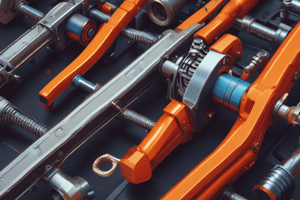Podcast
Questions and Answers
Which of the following statements accurately describe types of simple machines?
Which of the following statements accurately describe types of simple machines?
- Must be complex machines
- Can be combined into a complex machine (correct)
- Does work with only one movement (correct)
- Requires multiple movements to function
What are the six types of simple machines?
What are the six types of simple machines?
Lever, pulley, wheel and axle, inclined plane, screw, wedge
What is a lever?
What is a lever?
A bar that is free to pivot or turn at a fixed point
What is a fulcrum?
What is a fulcrum?
The output force produced by a lever depends on ___________________________.
The output force produced by a lever depends on ___________________________.
What characterizes a 1st class lever?
What characterizes a 1st class lever?
Give examples of a 1st class lever.
Give examples of a 1st class lever.
What characterizes a 2nd class lever?
What characterizes a 2nd class lever?
Give examples of a 2nd class lever.
Give examples of a 2nd class lever.
What characterizes a 3rd class lever?
What characterizes a 3rd class lever?
Give examples of a 3rd class lever.
Give examples of a 3rd class lever.
What does FLEX stand for in levers?
What does FLEX stand for in levers?
What is the Ideal Mechanical Advantage (IMA) of a lever?
What is the Ideal Mechanical Advantage (IMA) of a lever?
Flashcards are hidden until you start studying
Study Notes
Simple Machines: Levers Overview
- Simple machines perform work with one movement and can be combined for complex machines.
- There are six types of simple machines: lever, pulley, wheel and axle, inclined plane, screw, and wedge.
Lever Definition
- A lever is a rigid bar free to rotate around a fixed point known as the fulcrum.
- The output force produced by a lever is influenced by the lengths of its arms.
Fulcrum
- The fulcrum is the pivot point of a lever, determining how the lever operates.
Types of Levers
1st Class Lever
- Fulcrum is situated between input and output forces.
- Examples include scissors (composed of two levers), crowbars, and seesaws.
2nd Class Lever
- Effort and fulcrum are positioned at opposite ends, with the load in-between.
- Common examples are wheelbarrows and bottle openers.
3rd Class Lever
- The effort is applied between the fulcrum and the load.
- Examples include baseball bats, tweezers, and fishing poles.
FLEX Mnemonic
- F = Fulcrum in the middle
- L = Load in the middle
- E = Effort in the middle
- X = Represents a fun aspect (not a component of levers)
Ideal Mechanical Advantage (IMA)
- IMA formula: Length of input arm / Length of output arm.
- Shortening the output arm increases mechanical advantage, making tasks easier.
Studying That Suits You
Use AI to generate personalized quizzes and flashcards to suit your learning preferences.




